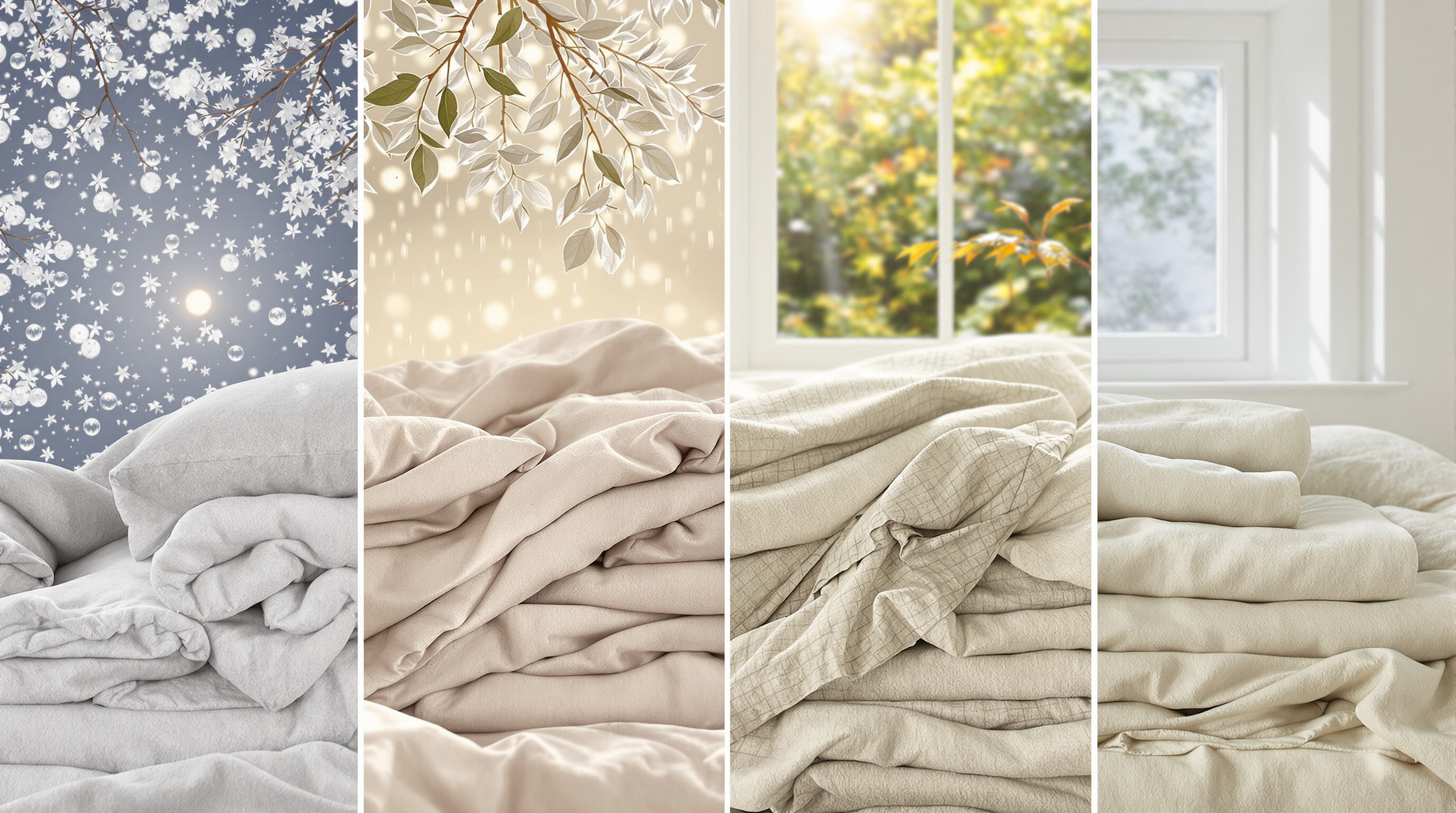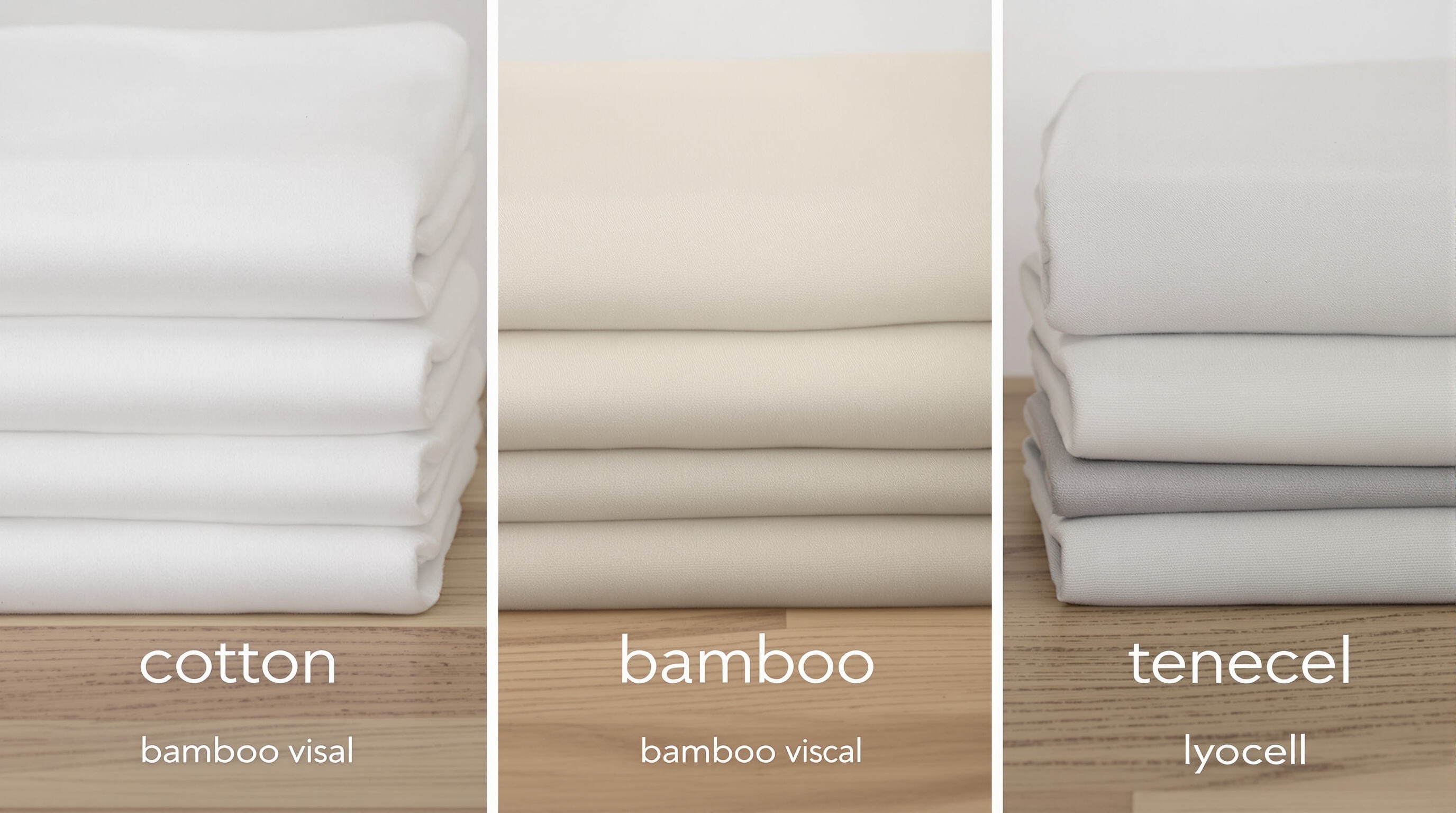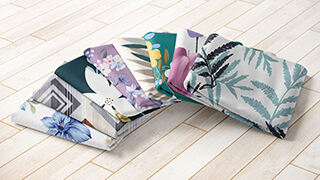How Climate and Season Affect Bedding Fabric Performance

Understanding Seasonal Suitability of Bedding Fabrics
Bedding fabric performance hinges on seasonal demands. Summer calls for breathable materials like cotton and linen to combat heat, while winter requires insulating options such as wool or brushed flannel. In transitional seasons, adaptive blends like Tencel balance airflow and warmth, offering consistent comfort across shifting temperatures.
How Climate Impacts Sleep Comfort and Temperature Regulation
How well we sleep depends a lot on whether our bedding supports the body's natural cooling down process at night. When we enter REM sleep, our core temp usually goes down about 1 to 2 degrees Fahrenheit. Materials that hold onto heat, especially stuff like polyester sheets, can really mess with this important cooling phase. For folks living in hot climates, bamboo fabric works wonders because it lets air circulate through those tiny pores, keeping things from getting too warm. Over in drier areas where nights get pretty chilly, linen that pulls sweat away from the skin becomes a real lifesaver against both the dryness and annoying static shocks that often happen when sleeping under normal conditions.
The Role of Humidity in Fabric Performance Across Seasons
Humidity intensifies bedding challenges: high levels cause synthetic fibers to retain heat and moisture, while low humidity increases static in wool. Natural fabrics like lyocell (Tencel) excel year-round by absorbing 50% more moisture than cotton, preventing clamminess in summer and dryness in winter without compromising breathability.
Case Study: Temperature Fluctuations and Fabric Adaptation in Temperate Zones
A 2023 sleep study in temperate climates found that households rotating between seasonal fabrics reduced nighttime awakenings by 37%. Participants used percale cotton in summer, linen-cotton blends in spring and fall, and wool-cotton mixes in winter, maintaining consistent sleep quality despite annual temperature swings of up to 40°F.
Breathable Natural Fabrics for Warm Weather: Cotton, Linen, and Bamboo
Cotton Sheets: Breathability and Warm-Weather Performance
Most people reach for cotton when they want bedding for summer nights because of how breathable it is. The structure of cotton fibers lets about 40 percent more air circulate around the body compared to those plastic-like synthetics we all know. A recent study found that folks sleeping on cotton sheets wake up less during hot, muggy nights than those using polyester blends, though specifics vary depending on who's doing the measuring. What makes cotton work so well? Those little natural crimps in the fibers create small spaces between them, kind of like built-in ventilation channels. This means cotton keeps us warm enough without feeling stuffy, which is why it works great when temperatures climb past 75 degrees Fahrenheit or so. Most bedroom environments fall into this range anyway.
Percale vs. Sateen Weaves: Impact on Cooling and Airflow
Thread arrangement significantly influences thermal performance:
| Weave Type | Thread Count Range | Surface Feel | Airflow Rating (1-5) | Best For Seasons |
|---|---|---|---|---|
| Percale | 200-400 | Crisp, matte | 4.8 | Summer |
| Sateen | 300-600 | Silky, lustrous | 3.1 | Winter/Shoulder |
Percale’s simple over-under weave maximizes breathability, while sateen’s floating threads enhance softness at the expense of airflow, making it better suited for cooler months.
Linen Sheets: Lightweight Breathability for Hot Sleepers
Tests from the European Textile Lab show linen has hollow fibers that soak up about 20 percent more moisture than regular cotton fabric before it starts to feel wet. The weave itself is pretty different too. Linen fabric tends to be much looser, around 30% more open compared to standard cotton weaves. This creates little air pockets throughout the material. These natural gaps help keep things cool during sleep, dropping surface temps somewhere between 4 and 7 degrees Fahrenheit (that's roughly -16 to -14 Celsius) when tested under controlled conditions. For people who tend to get warm at night, this makes linen an excellent choice for staying comfortable through the night.
Bamboo-Derived Viscose: Cooling Properties and Moisture-Wicking Performance
Tests under ASTM F1868 standards show bamboo rayon wicks away sweat at about 1.5 times the rate of regular cotton. The fabric has these tiny grooves in the fibers that actually pull moisture along them, spreading it out over nearly the entire surface area of the material. This helps things dry quicker, which makes all the difference when someone is wearing it in hot, humid places like tropical regions. Still worth mentioning though, the way bamboo rayon gets made involves quite a few chemicals, so from an environmental standpoint it doesn't measure up as well against materials like organic linen or even organic cotton options on the market today.
All-Season Innovations: Eucalyptus and Tencel (Lyocell) for Temperature Regulation
Lyocell (Tencel) for Balanced Temperature Regulation in Bedding
Tencel lyocell fabric brings together good breathability and really effective moisture management, which makes it better than most regular fabrics on the market today. The material comes from wood pulp that's harvested in sustainable ways, and interestingly enough, it can soak up around 50 percent more moisture than cotton does without losing its ability to let air circulate properly. What sets this fabric apart is its smooth texture with tightly packed fibers that stop body heat from building up during warm weather but still keep some warmth when temperatures drop in winter time. That's why people find it comfortable throughout all seasons. According to various sleep studies conducted by experts in the field, those who switch to lyocell bedding report waking up less frequently at night compared to using polyester mix sheets. For folks who tend to get too warm while sleeping, this difference can make a real impact on their quality of rest.
Eucalyptus-Based Fabrics as Sustainable Cooling Sheet Materials
Lyocell made from eucalyptus trees is pretty impressive when it comes to being green and keeping people cool. These trees grow super fast and need way less water compared to growing cotton – we're talking around 95% less actually. Plus, the way they make this fabric recycles most of what they use so there's not much chemical waste left over. What's interesting too is how these fibers seem to fight off dust mites and other stuff that makes allergies worse. Some research on indoor air quality backs this up, which means folks who struggle with allergies might find relief wearing clothes made from this material. And let's not forget about those tiny grooves in the fiber structure that pull sweat away from skin at least 40% quicker than regular rayon does. That kind of performance makes all the difference when temperatures rise or humidity gets high.
Moisture Management and Softness: Tencel vs. Rayon and Other Cooling Fabrics
| Property | Tencel Lyocell | Bamboo Rayon | Cotton |
|---|---|---|---|
| Moisture Absorption | 12.5% | 8.2% | 6.7% |
| Drying Time (minutes) | 45 | 70 | 90 |
| Bacterial Growth Inhibition | 99% | 85% | 65% |
Tencel’s hydrophilic fibers dry 35% faster than bamboo rayon and resist bacterial growth more effectively. Unlike traditional viscose, lyocell retains softness after repeated washing due to its durable fiber structure.
Industry Paradox: High Performance vs. Premium Pricing of Lyocell Bedding
Lyocell bedding typically costs 20–40% more than cotton, largely due to its sustainable production process, which recycles 99% of solvents. However, its long-term value is clear: over five years, lyocell sheets retain 85% of their cooling efficiency, compared to 55% for bamboo-rayon blends, according to textile lifecycle analyses.
Comparative Performance of Top Cooling Bedding Fabrics for Hot Sleepers

Cooling sheets for hot sleepers: Cotton, bamboo, and Tencel compared
When it comes to how well fabric lets air pass through, cotton still stands out as the gold standard. Natural fibers in cotton allow for much better airflow, which actually cuts down on night sweats by around 31% when compared to synthetic materials according to some recent industry research from 2024. Then there's bamboo viscose, which seems to soak up moisture even better than regular cotton does. Tests show it can hold about 40% more humidity but somehow stays cooler to the touch too, something thermal images have confirmed. And speaking of innovation, Tencel takes what works from both these materials. Made from engineered fibers, this stuff regulates body temperature about 22% better than cotton in lab settings, and it wicks away sweat just as effectively as bamboo fabrics do in real world conditions.
Thermal conductivity and sleep comfort across top bedding fabrics
Fabric density and weave critically influence heat dissipation:
| Fabric | Heat Retention (W/m·K) | Moisture Evaporation Rate | Ideal Season |
|---|---|---|---|
| Cotton Percale | 0.26 | 4.2g/h | Summer |
| Bamboo Viscose | 0.19 | 5.1g/h | Tropical |
| Tencel Lyocell | 0.21 | 4.8g/h | All-Season |
Weave matters as much as material—percale facilitates 18% faster airflow than sateen, according to textile engineering reports. Even inherently cooling fibers like bamboo can trap heat if tightly woven, underscoring the importance of construction in thermal performance.
Data insight: Consumer sleep studies on temperature-regulating bedding materials
Research from 2023 looked at 500 people who tend to get hot while sleeping and found something interesting. Those using lyocell bedding woke up during the night about 40% less often compared to folks with cotton bedding, although comfort levels did depend on where they lived. The best results came from mixed setups actually. People who paired linen duvet covers with Tencel sheets maintained good body temperature control around 78% of the time in moderate climates. When it comes to areas with high humidity, most consumers (about 63%) cared more about how fast their bedding dried after sweating rather than just focusing on keeping cool. This shows why picking the right bedding materials really matters depending on local weather conditions.
FAQ Section
What are the best fabrics for hot and humid climates?
In hot and humid climates, breathable fabrics such as bamboo viscose and cotton are ideal. Bamboo viscose wicks moisture effectively and stays cool to the touch, while cotton allows better airflow.
How does fabric weave affect bedding performance?
Weave types like percale and sateen influence breathability and thermal comfort. Percale boosts airflow for cooler sleep environments, while sateen enhances softness, suitable for cooler weather.
Why is Tencel considered an all-season fabric?
Tencel's balanced moisture management and breathable properties make it suitable for both warm and cool seasons. It prevents heat buildup while retaining warmth during colder months.
Are bamboo-derived fabrics environmentally friendly?
Bamboo fabrics involve chemical processing, making them less eco-friendly than organic cotton or linen. However, they perform exceptionally well in moisture management and thermal regulation.








